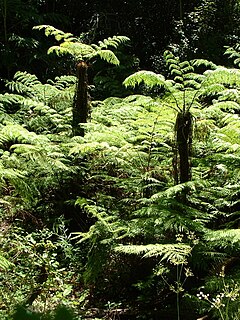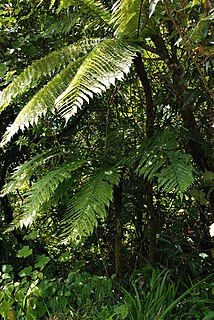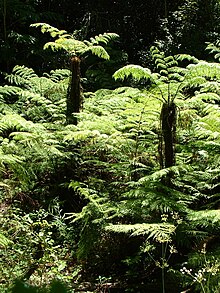
Sphaeropteris cooperi, synonym Cyathea cooperi, also known as lacy tree fern, scaly tree fern, or Cooper's tree fern, is a tree fern native to Australia, in New South Wales and Queensland.
Alsophila abbottii, synonym Cyathea abbottii, is a species of tree fern in the family Cyatheaceae, native to Hispaniola, where it grows in shaded montane forest at an altitude of 700–1200 m. The trunk is erect and can grow up to 1.6 m in height and 5 cm in diameter. Fronds may reach 1.5 m in length and are pinnate. The rachis is brown and is covered in golden-brown to bicoloured basal scales. Sori are arranged in two rows along each side of the pinnule midvein. Indusia are rounded and in the shape of a cup.
Alsophila approximata, synonym Cyathea approximata, is a species of tree fern endemic to Madagascar.
Alsophila archboldii, synonym Cyathea archboldii, is a species of tree fern native to New Guinea and Bougainville, where it is common in submontane rain forest at an altitude of 1000–3000 m. The trunk is erect and up to about 3 m tall. Fronds are bipinnate and 2–3 m long. The rachis may be purplish and has short spines and scales. The scales range in colour from pale to brown, to bicoloured and have fragile edges. Sori occur in two rows along each side of the pinnule midvein and are covered by firm indusia.

Alsophila australis, synonym Cyathea australis, also known as the rough tree fern, is a species of tree fern native to southeastern Queensland, New South Wales and southern Victoria in Australia, as well as Tasmania and Norfolk Island.
Alsophila baileyana, synonym Cyathea baileyana, also known as the wig tree fern, is a species of tree fern native to northeastern Queensland in Australia, where it grows in wet gullies and forest at an altitude of 850–1200 m. It is a rare species that is seldom found in the wild. The erect trunk is 4–5 m tall, approximately 10 cm in diameter and may be covered in stipe bases in the upper regions. C. baileyana is notable for being able to develop offshoots from the base of the trunk. Fronds are bi- or tripinnate and may be exceptionally long, up to 7 m, though they are usually around 2–3 m. The rachis and stipe are dark to darkish red, scaly and may be warty, but lack spines. Scales on the rachis and stipe are purplish brown to black and have a long hair-like apex. Characteristically of this species, the last pair of pinnae are separated from the others along the rachis and may form a clump around the trunk apex. Sori are circular and occur in one to three rows along the pinnule midvein. They lack indusia.
Alsophila bryophila, synonym Cyathea bryophila, is a species of tree fern native to Puerto Rico, where it grows in the understory in wet montane and mossy forest at an altitude of 750–1200 m. The trunk is erect, up to 7 m tall and about 10 cm in diameter. Fronds are pinnate or bipinnate and grow to 2 m in length. The underside of the rachis is pubescent and has occasional scales towards the base. The scales range in colour from brown to bicoloured. Sori occur along each side of the pinnule midvein and are covered by scale-like indusia. A. bryophila is a slow growing species, reportedly only increasing in trunk height by 5 cm a year, a growth rate more akin to that of Dicksonia species. It has been estimated that plants may live in excess of 150 years.
Alsophila deckenii, synonym Cyathea deckenii, is a species of tree fern native to the Democratic Republic of the Congo, Tanzania and Mozambique, where it grows in wet forest at an altitude of 1350–2300 m. The trunk is erect and up to 10 m tall. Fronds are bipinnate and 2–3 m long. Characteristically of this species, the most basal one or two pairs of pinnae are reduced. The rachis and stipe range in colour from brown to dark brown or black-brown and are sparsely covered with a few scales. The scales are dark and narrow with a fragile margin of variable width. The stipe also has conical warts near the base. Sori are round and covered by large, thin indusia.
Alsophila decrescens, synonym Cyathea decrescens, is a species of tree fern endemic to Madagascar.

Alsophila dregei, synonym Cyathea dregei, is a widespread species of tree fern in southern Africa.
Alsophila engelii, synonym Cyathea elongata, is a species of tree fern native to Venezuela and Colombia, where it grows in montane areas at an altitude of 2000–3000 m. The trunk is erect and up to 11 m tall. Fronds are pinnate and usually 2–3 m long. The rachis and stipe are brown, may be smooth to warty and have basal tan scales. Sori occur in small groups towards the base of the pinnule midvein and are covered by cup-like indusia.

Alsophila erinacea, synonym Cyathea erinacea, is a species of tree fern native to Mexico, Costa Rica, Panama, Venezuela, Colombia, Ecuador, Peru and Bolivia.
Alsophila gigantea, synonym Cyathea gigantea, is a species of tree fern native to northeastern to southern India, Sri Lanka, Nepal to Myanmar, Thailand, Laos, Vietnam, the Malay Peninsula, as well as central Sumatra and western Java. It grows in moist open areas at an altitude of 600–1000 m. The trunk of this species is erect and may be as tall as 5 m or more. Fronds are bi- or tripinnate and usually 2–3 m long. The rachis is long, dark to black in colouration and rough in appearance after the fall of scales. These scales are dark brown, glossy and have a narrow paler margin and fragile edges. Sori are round and indusia absent.
Alsophila grevilleana, synonym Cyathea grevilleana, is a species of tree fern endemic to Jamaica, where it grows in moist gullies and on wooded hills in both calcareous and noncalcareous soils at an altitude of 200–1200 m. The trunk of this plant is erect, about 7 m tall, and 10–15 cm in diameter. It is characteristically clothed in old stipe bases, brown scales and blackish spines. Fronds are tripinnate, dark green in colour, and up to 4 m in length. The last pinnae are sometimes separated, forming a distinctive clump around the trunk apex. The rachis is yellow-brown and almost smooth. This species has a long, dark brown stipe with a few scattered spines. Sori are produced in four to six pairs along the pinnule midvein. They are protected by pale brown indusia that are cup-like in appearance.
Alsophila hornei is a species of tree fern in the Cyatheaceae family.
Alsophila humilis, synonym Cyathea humilis, is a species of tree fern native to Kenya, as well as the Usambara and Uluguru Mountains in Tanzania, where it grows in wet forest at an altitude of 1100–2000 m. The trunk of this plant is erect and 2–3 m tall. Fronds are pinnate and 1–2 m in length. Dead fronds are often retained in the typical variety, forming an irregular skirt around the trunk. The rachis and stipe are light brown in colouration. Scales are present towards the base of the stipe. They are dark, glossy, and have narrow, fragile edges. Sori occur at the forks of veins and are protected by thin, reduced indusia.
Alsophila imrayana, synonym Cyathea imrayana, is a species of tree fern native to Dominica, Costa Rica, Panama, Venezuela, and Ecuador.

Alsophila is a genus of tree ferns in the family Cyatheaceae. It has also been considered to be a section in the subgenus Cyathea of the genus Cyathea.

Alsophila glaucifolia, synonym Cyathea glauca, is a species of tree fern endemic to Réunion. Little is known about this species.

Alsophila borbonica, synonym Cyathea borbonica, is a tree fern endemic to Mauritius and Réunion. There are several natural forms and varieties.








